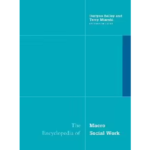Naomi Almeleh, Steven Soifer,
Naomi Gottlieb, and Lorraine Gutierrez
In social work, workplace activism has been overlooked as a source of empowerment for women clients. This article reports on the results of a case study of a predominantly female union engaged in grassroots organizing and legislative activity to promote comparable worth. An unanticipated finding of the study was the high degree to which personal, interpersonal, and political empowerment took place among the women who were deeply involved in the campaign for comparable worth. Social workers need to be more aware of the potential that workplace organizing and political action offer for the empowerment of their women clients.
Social workers have traditionally been concerned with women’s roles as wives and mothers. With the recognition that most women also work outside the home, more attention has been paid to the role of work in women’s lives, but the emphasis has remained on issues of stress and conflicts between the demands of work and family. Feminist social workers have gone beyond this focus to recognize the workplace as an arena for women to develop their abilities and gain some economic power. They have also acknowledged the societally imposed problems that working women
AFFILIA, Vol. 8 No. 1, Spring 1993 26-39
©1993 Sage Publications, Inc.
Page 1
| Almelel et al. |
face, such as sex discrimination, job segregation, and pay inequity (Gottlieb, 1987).
Some social workers have taken to heart the feminist adage that the personal is political and understand that the economic woes of an individual female client are intimately connected to the position of women in society, as mediated by race, class, and sexual orientation. However, the equation must not stop with an analysis of what is wrong. Social workers also need to be aware that when women clients take action against the injustices in their workplace, this action can result in their personal and political empowerment.
This article describes how in one clerical union, organizing for comparable worth resulted in personal, interpersonal, and political empowerment for the women involved in the campaign. As this case study shows, workplace organizing is not only a way to achieve collective power for women workers but also provides an opportunity for developing the political talents of working women.
DEFINING COMPARABLE WORTH
Comparable worth, also known as pay equity, is an important issue for social work because it could be a key element in ending the poverty of women and in correcting the underpayment of women in predominantly female occupations, including social work (Freeman, 1991). Women’s groups, civil rights organizations, and unions have been advocating comparable worth for many years (Freeman, 1991). University faculty women, including social work educators, have also been involved in legal battles for pay equity (Leonard, 1986).
Comparable worth seeks to address the underpayment of women in the workplace. Over 80 percent of women work in only 25 female job categories. One of the consequences of such intensive segregation in female-dominated jobs is that workers earn 20 percent less than workers in comparable male-dominated jobs (Kahn & Grune, 1982).
Page 2
| Affilia, Spring 1993 |
Women’s subordinate position in society is responsible for job segregation and low wages (Gottlieb, 1987; Lewis, 1988).
Comparing jobs of equal value for salary-setting purposes is one way to eliminate wage discrimination based on sex or race. The basic premise underlying comparable worth is that “pay should be based on job-related factors such as skill, effort, responsibility, and working conditions, not on a worker’s gender or race” (National Committee on Pay Equity, 1989, p. 4).
FEMINIST ORGANIZING FOR EMPOWERMENT
Feminist organizing theory and feminist analyses of practice provide a context for understanding working women’s organs- sizing for comparable worth (Adamson, Briskin, & McPhail, 1988; Bookman & Morgan, 1988; Brandwein, 1981; Gutierrez & Lewis, 1992; Joseph et al., 1989; Riger, 1984; Weil, 1986). Feminist organizing seeks to “raise constituents’ political consciousness and to challenge the existing patriarchal capitalist system” (Bradshaw, Soifer, & Gutierrez, in press, p. 6). The feminist belief that the personal is political links personal actions with structural conditions (Bradshaw et al., in press).
One of the distinctive elements of feminist organizing practice is empowerment through the “integration of action and reflection” (Gutierrez & Lewis, 1992, p. 117). Using empowerment strategies to understand, confront, and change gender-based power inequities is an important aspect of feminist organizing. Understanding empowerment requires recognizing the role that power can play in social relationships. Feminist theory has moved beyond depicting power solely as an exploitative and scarce resource to a perspective that assumes that power has the potential to be a positive force that can be generated in the process of social interaction (Bricker-Jenkins & Hooyman, 1986). This perspective defines power in three ways (Dodd & Gutierrez, 1990).
Page 3
| Almelelt et al, |
Personal power involves experiencing oneself as an effective and capable person. One means of increasing personal power is to identify and understand one’s own power. Many social work theories are focused primarily on this level of empower- ment (Simon, 1950).
Interpersonal power is the ability to influence others through the use of social power. Social power can be derived from one’s social position (for example, as a supervisor), one’s role (for instance, as a parent), one’s interpersonal skills (for example, conversational ability), one’s credibility (appearing knowledgeable), or one’s attractiveness (either physical or personal) (Feld, 1987; French & Raven, 1968). Some of these bases of power are ascriptive—based on race, gender, or clas —but others can be achieved as one develops social skills or attains new social positions. Identifying deficits in skills and learning new skills are key elements in the empowerment process.
Political power is the ability to influence the allocation of resources in an organization or community through formal or informal means (Parenti, 1978). Political power is most commonly gained through collective action and collaboration with others. Women, along with other oppressed groups, have often been denied political power, so this continues to be an important area of feminist concern.
The empowerment of women can involve increasing any of these kinds of power or some combination of them. It requires bringing together a sense of personal control with the ability to influence the behavior of others, focusing on enhancing the existing strengths of individuals or communities and establishing equity in the distribution of resources (Biegel & Naperste, 1982; Bricker Jenkins & Hooyman, 1986; Katz, 1984; Kieffer, 1984; Rappaport, 1985; Van den Bergh & Cooper, 1986). A feminist perspective on empowerment focuses specifically on how individual women have been affected by the forces of racism, ethnocentrism, classism, sexism, and heterosexism and on ways in which social structures can be challenged. Increased personal power is only one of the elements needed to change
Page 4
| Affilia, Spring 1993 |
oppressive structures (Bricker-Jenkins & Hooyman, 1986; Gould, 1987; Gutierrez, 1988). In working to achieve pay equity, organizers can focus on all three levels of empowerment.
BACKGROUND
The Classified Staff Association/ District 925 (CSA /925), affiliated with District 925 of the Service Employees International Union has been involved in working for comparable worth in Washington State from its preunion days in 1981 to the pres- ent. C5A/925 is currently the largest union at the University of Washington, as well as the largest clerical bargaining unit in the state, representing over 3,000 classified staff employees working in clerical, supervisory, data processing, and media jobs (Classified Staff Association/District 925, 1989). Because CSA/925 represents an overwhelmingly female workforce (about 95 percent) and virtually all CSA. /925 elected officers are women, CSA /925 focuses its energies on issues of concern to women workers. CSA/925 fought for comparable worth because its members were the primary beneficiaries of this policy.
In reading scholarly accounts of the struggle for comparable worth in Washington State (Hutner, 1986; Newman, Newell, & Kirkman, 1985; Remick, 1980, 1986), one finds it difficult to discern what role, if any, working women had in the movement because they are rarely mentioned. Thus, much of the information for this article was provided by 11 female comparable-worth activists, interviewed between May and November 1990, for a case study of CSA /925 that focused on working women’s organizing for comparable worth (Almeleh, 1991). The informants included five past leaders of CSA /925, three union staff, and three comparable-worth advocates who worked with CSA/925 on the issue.
A 1982 class action lawsuit, AFSCME v. Washington, brought by the American Federation of State, County, and Municipal Employees (AFSCME) and the Washington Federation of State Employees, was the main catalyst for comparable worth in
Page 5
| Almeleh et al. |
Washington State. CSA /925’s primary contributions to comparable worth were (1) its grass-roots organizing from 1983 to 1986, which helped pressure the Washington legislature to adopt comparable-worth legislation and appropriate money, and (2) its influence with legislative committees and the Higher Education Personnel Board while comparable worth policies were being implemented.
In its lawsuit, AFSCME asked the federal district court to require the state to pay workers in female-dominated occupations equal pay for work of comparable worth based on the state’s own salary studies. In 1983, the court ruled that the state of Washington had to implement comparable worth to end sex-based discrimination. The state appealed, and in 1985, the Ninth Circuit Court of Appeals ruled against the mandatory implementation of comparable worth.
However, the 1983 Washington legislature passed a bill that committed the state to the philosophy and practice of comparable worth. This legislative commitment, combined with CSA/925’s aggressive legislative lobbying throughout the duration of the lawsuit, paved the way for continuing negotiations on comparable worth during the state’s appeal and even after the Ninth Circuit Court of Appeals” devastating ruling. The result was a schedule for implementing comparable worth, negotiated by AFSCME and the state. For a more detailed discussion of the legal and legislative history of comparable worth in Washington State, see Hutner (1986) and Almeleh (1991).
The thread that connects CSA/925’s use of different strategies for achieving comparable worth is the emphasis on grassroots organizing. CSA/925’s legislative activity was much more than just lobbying by professionals. On a number of occasions, CSA /925 members traveled to the state capital to lobby their representatives and to deliver thousands of postcards from other members. Comparable-worth “alerts” generated hundreds of phone calls to legislators. Union members also presented testimony at hearings of the legislative committee, and CSA/925 members were actively involved in all aspects of
Page 6
| Affilia, Spring 1993 |
implementing comparable worth at the Higher Education Personnel Board.
THE EXPERIENCE OF CSA/925 ACTIVISTS
The successful legislative activity taught CSA/925 members that they could be effective political actors. One dynamic leader recounted how intimidated she felt on her first lobbying visit but that she was ready to speak her mind the next year when she knew what to expect. Another activist, who described herself as politically inactive before becoming involved with comparable worth, attributed her involvement to her positive lobbying experience. An observer described a third activist as an insecure person who grew stronger and more confident through her experiences as an organizer for comparable worth until she became “a lion.”
In the words of one activist, “Since the legislature is the state employees’ boss, it is a way for women to confront their employer.” As one leader put it when women workers take themselves seriously and stand together, they have a lot to say about their work environment, wages, and conditions.
A leader explained how comparable worth encouraged women workers to ask themselves if their work was valued properly and whether new job titles were needed. Another activist stated that fighting for and winning comparable worth raised CSA/925 members’ self-esteem and galvanized women to fight for dignity and respect as well as for pay and promotions.
An observer commented that comparable worth was political because it raised questions about the cultural value of women’s work and changed how women workers felt about themselves. Another activist said that comparable worth helped women workers become aware that their low pay was
caused by sex discrimination. She saw comparable worth as a catalyst that prepared women to take on other important workplace issues, such as stopping sexual harassment and ending supervisors” expectations of personal services—for instance,
Page 7
| Almeleh et al. |
making coffee. One leader thought that women workers learned to work together in the comparable-worth campaign and that thinking about sex-based pay discrimination led to a consciousness of other women’s issues, such as child care, health care, and domestic violence.
OUTCOMES OF C5A/925 ORGANIZING
The movement for comparable worth in Washington State brought about four important advances for working women: pay equity, the valuing of women’s work, increased self-esteem, and attention to working women’s issues.
Pay equity was an important outcome of the efforts to attain comparable worth. Although “true” comparable worth was not achieved (the settlement agreed to raise female-dominated occupations to only 95 percent of their calculated comparable worth), pay-equity activists managed to effect large pay increases for the most underpaid and undervalued women’s occupations. CSA/925’s lobbying in the state legislature and advocacy at the Higher Education Personnel Board brought about significant raises to some of the lowest-paid women workers in state employment (CSA /925, 1986).
Putting more money into women’s pockets is essential if women are to gain freedom from financial dependence on male partners or the state. According to one CSA /925 leader, many single office workers at the University of Washington had previously received such low pay that they were eligible for Aid to Families with Dependent Children. Comparable-worth salary increases raised some women’s incomes above the poverty level and brought women’s income levels somewhat closer to men’s.
A second important outcome of comparable worth was the valuing of women’s work. The method of implementing comparable worth in Washington State required rewriting job descriptions, rating jobs on a point system, and comparing jobs for salary-setting purposes. The extensive reevaluation made
Page 8
| Affilia, Spring 1993 |
male personnel officers, union leaders, supervisors, and state workers aware that discrimination and undervaluation were the causes of women’s low wages.
Comparable worth encouraged office workers who were represented by CSA /925 to take pride in their work. CSA /925 activists began to wear buttons reading “Office Worker and Proud of It.” They became vocal critics of the university’s administration, which ignored their contributions and disparaged their work. As one union leader reported, “You never hear women say, ‘I’m just a secretary’ anymore.”
One striking way in which comparable worth changed the lives of CSA/925 activists was to enhance their self-esteem, through the higher valuation of their work, pay increases, and individual and collective empowerment. The National District 925 slogan, “We’re Worth I!” which came from CSA/925’s comparable-worth efforts, captures the spirit of the struggle. For a woman to fight for herself and her co-workers, she needs to believe in her own worth.
The campaign for comparable worth helped to build CSA/925 an organization that pays serious attention to working women’s issues. As a predominantly female union, with female leaders and female staff, this focus may not seem surprising. However, in the context of the labor movement, whose staff and leadership are predominately male and is only beginning to integrate working women’s concerns, CSA /925’s emphasis on women’s issues is significant. CSA /925 also helped to put working women’s concerns on the agendas of other groups, such as feminist organizations, labor councils, and other unions.
Through the struggle for comparable worth, CSA /925 and its activists came to see their entitlement to dignity and respect in their workplace. As one leader put it, “If you are dealing with dignity in the workplace, comparable worth in salary is dignity.”
EMPOWERMENT OF WORKING WOMEN
One unanticipated discovery during this case study was the degree to which working women were empowered through
Page 9
| Almeleh et al. |
CSA/925’s organizing for comparable worth. The personal aspect of their empowerment was an increased sense of self-esteem and self-worth as they figured out that they and their co-workers performed valuable work at the university and deserved higher pay. The interpersonal and political aspects of their empowerment took place in the process of becoming politically active. Women who became involved in working for comparable worth realized, often for the first time, that they could make a difference. The transformation of CSA /925 from an association to a certified bargaining unit representing 3,200 workers brought with it a sense of collective power, which continued to develop as the union fought for comparable worth.
As activists experienced feelings of increased power, they also increased their actual political power. Individuals who came into the union because of their interest in comparable worth became stewards, committee chairs, elected officers, and staff for the union. They became effective advocates for working women on campus at the bargaining table, at the Higher Education Personnel Board, and in the state legislature.
The union’s actively involved membership and the members’ technical expertise gained the respect of legislators. CSA /925 members proved their political effectiveness in efforts to adopt comparable-worth legislation, obtain appropriations, and plan the implementation of comparable-worth provisions. As members of a brand-new union, they left their mark on the movement for comparable worth in Washington State.
At a ceremony celebrating the 1983 comparable-worth successes and CSA /925’s first contract, two speakers made explicit connections between comparable worth and power. State Senator Nita Rinehart reminded the CSA /925 supporters of Shirley Chisholm’s words: “Nobody gives you power. You have to take it” (CSA /925, 1984, p. 2). State Representative Jennifer Belcher later told the audience: “Comparable worth is all about money and control, and who controls the money and power in this country” (C5A/925, 1984, p. 3). During the years of organizing for comparable worth, CSA /925 activists proved that they could exert their collective power as unionists and as working women.
Page 10
| Affilia, “Spring 1993 |
CSA /925’s comparable-worth efforts follow the feminist conceptualization of empowerment discussed earlier. As individuals developed increased feelings of personal power from their work on comparable worth, they contributed to a sense of group empowerment. CSA /925’s successes as a union also encouraged the activism and leadership development of the participants. This interaction between individual and group empowerment was one of the most exciting aspects of CSA/925s organizing for comparable worth. Empowerment is not necessarily always part of the process for comparable worth, as the case of Minnesota demonstrates. Evans and Nelson (1989) called the comparable-worth effort in Minnesota a “technocratic reform” because working women there were not included in the process and were barely aware of its existence. By comparison, CSA /925’s efforts involved and inspired new union activists and empowered them as political actors.
CONCLUSION
Fighting for comparable worth was a transformational experience for the CSA /925 activists. For the women workers who were involved in the campaign, the results were much more than just a larger paycheck. The outcomes of CSA /925’s organizing —helping to obtain pay equity, valuing women’s work, increasing self-esteem, and bringing attention to working women’s issues—are important successes. The impressive degree to which personal, interpersonal, and political empowerment took place is a model for any kind of feminist organizing.
CSA /925’s experience with organizing for comparable worth offers the opportunity to reflect on a number of issues related to feminist social work. How can social workers promote organizing for comparable worth to reduce the poverty of women? How can underpaid social workers organize and empower themselves to fight for pay equity for social workers? How can social work educators and administrators understand and support the struggle of office workers in their own institutions?
Page 11
| Almeleh et al. |
The CSA/925 experience demonstrates the importance of workplace organizing and other types of political action as sources of empowerment for women. As a vehicle for obtaining higher pay and more recognition for the valuable work that women perform, comparable worth is a valuable strategy for both social workers and their women clients.
REFERENCES
Adamson, N., Briskin, L., & McPhail, M. (1988). Feminist organizing for change: The contemporary women’s movement in Canada. Toronto: Oxford University Press.
Almeleh, N. (1991). Working women organizing for comparable worth: The case of the Classified Staff Association/District 925. Unpublished master’s thesis, Vermont College of Norwich University, Montpelier.
Biegel, D., & Naperste, A. (1982). The neighborhood and family services project: An empowerment model linking clergy, agency, professionals and community residents. In A. Jaeger & R. Slotnick (Eds.), Community mental health and behavioral ecology (pp. 303-318). New York: Plenum.
Bookman, A., & Morgan, S. (1588), Women and the politics of empowerment, Philadelphia: Temple University Press.
Bradshaw, C., Soifer, S., & Gutierrez, L. (in press). Toward a hybrid model for effective organizing in communities of color, Administration in Social Work.
Brandwein, R. A_ (1981). Toward the feminization of community and organization practice, Social Development Issues, 5, 180-193.
Bricker-Jenkins, M., & Hooyman, N. (1986). A feminist worldview: Ideological themes from the feminist movement. In M. Bricker-Jenkins & N. Hooyman (Eds.), Not for women only: Social work practice for a feminist future (pp. 7-22). Silver Spring, MD: National Association of Social Workers.
Classified Staff Association/ District 925. (1984). April 25 contract signing ceremony and Secretaries Day rally (Transcript). Seattle, WA: Author.
Classified Staff Association/ District 925. (1986). The April 1 comparable worth raise (Memorandum). Seattle, WA: Author.
Classified Staff Association/District 925. (1989). CSA/925 gives us a voice. Seattle, WA: Author.
Dodd, P., & Gutierrez, L. (1990). Preparing students for the future: A power perspective on community practice. Administration in Social Work, 14(2), 63-78.
Evans, S. M., & Nelson, B., J. (1989). Wage justice: Comparable worth and the paradox of technocratic reform. Chicago: University of Chicago Press.
Feld, A. (1987). Sclf-perceptions of power: Do social work and business students differ? Social Work, 32, 225-230.
Freeman, M. L. (1991). Pay equity and social work. Affilia, 6(1), 7-19.
Page 12
| Affilia, Spring 1993 |
French, J., & Raven, B. (1968). The bases of social power. In D. Cartwright & A. Zander (Eds.), Group dynamics (3rd ed., pp. 259-269). New York: Harper & Row.
Gottlieb, N. (1987). Sex discrimination and inequality. In A. Minahan (Ed.), Encyclopedia of social work (Vol. 2, pp. 561-569). Silver Spring, MD: National Association of Social Workers.
Gould, K. (1987). Life model vs. conflict model: A feminist perspective. Social Work, 32, 346-351.
Gutierrez, L. M. (1988, November). Working with women of color: An empowerment perspective. Paper presented at National Professional Symposium, National Association for Social Workers, Philadelphia.
Gutierrez, L., & Lewis, E. (1992). A feminist perspective on organizing with women of color. In FE. Rivera & J. Erlich (Eds.), Community organizing in a diverse society (pp. 113-132). Boston: Allyn & Bacon.
Hutner, FE. C, (1986). Equal pay for comparable worth: The working woman’s issue for the eighties. New York: Praeger.
Joseph, B., Lob, S., McLaughlin, P., Mizrahi, T., Peterson, J., Rosenthal, B., & Sugerman, F. (1989). Feminist organizing principles. New York: Hunter College School of Social Work, Education Center for Community Organizing / Women Organizers’ Collective.
Kahn, W., & Grune, J. A, (1982). Pay equity: Beyond equal pay for equal work. In E. Boneparth (Ed.), Women, power, and policy (pp. 75-89). New York: Pergamon.
Katz, R. (1984). Empowerment and synergy: Expanding the community’s healing resources. In J. Rappaport, C. Swift, & R. Hess (Eds.), Studies in empowerment: Steps toward understanding and action (pp. 210-226). New York: Haworth.
Kieffer, C. (1984). Citizen empowerment: A developmental perspective. In J. Rappaport, C. Swift, & R. Hess (Eds.), Studies in empowerment: Steps toward understanding and action (pp. 9-36). New York: Haworth.
Leonard, E. L. (1986). Faculty women for equity: A class action suit against the state of Oregon. Affilia, (2), 6-19. .
Lewis, I. J. (1988). Just give us the money: A discussion of wage discrimination and pay equity. Vancouver, BC: Women’s Research Centre.
National Committee on Pay Equity. (1989). Pay equity activity in the public sector: 1979-1989 (Executive summary). Washington, DC: Author,
Newman, W., Newell, L., & Kirkman, A. (1985). The lessons of AFSCME v. State of Washington. New York University Review of Law and Social Change, 13, 475-497.
Parenti, M. (1978). Power and the powerless. New York: St. Martin’s.
Rappaport, J. (1985). The power of empowerment language. Social Policy, 17(2), 15-21.
Remick, H. (1980). Beyond equal pay for equal work: Comparable worth in the state of Washington. In R. S. Ratner (Ed.), Equal employment policy for women (pp. 405-419). Philadelphia: Temple University Press.
Remick, H. (1986). The case of comparable worth in Washington State. Policy Studies, 5, 838-848.
Page 13
| Almeleh et al, |
Riger, S. (1984). Vehicles for empowerment: The case of feminist movement organizations, In J. Rappaport, C. Swift, & R. Hess (Eds.), Studies in empowerment: Steps toward understanding and action (pp- 99-117). New York: Haworth.
Simon, B. (1990). Rethinking empowerment. Journal of Progressive Human Services, 1, 27-40.
Vanden Bergh, N., & Cooper, L. (Eds). (1986). Feminist visions for social work. Silver Spring, MD: National Association of Social Workers,
Weil, M. (1986). Women, community, and organizing. In N. Van den Berg & L. Cooper (Eds.), Feminist visions for social work (pp. 187-210). Silver Spring, MD: National Association of Social Workers.
Naomi Almeleh is an ID candidate, at Vermont Law School, South Royalton. Steven Soifer is the Assistant
Professor, School of Social Work, University of Washington, Seattle. Naomi Gottlieb is a Professor,
School of Social Work, University of Washington. Lorraine Gutierrez is an Assistant Professor, at the School
of Social Work, University of Washington.










Way cool! Some extremely valid points! I appreciate you penning this article plus the rest of the site is also really good.
Women’s achievement of empowerment through activism in the workplace is a crucial step towards dismantling entrenched biases and creating more inclusive spaces. Activism serves as a catalyst for change, inspiring others to challenge the status quo and strive for greater equality
Women’s achievement of empowerment through activism in the workplace is a testament to their resilience, determination, and collective strength. Whether it’s organizing for better parental leave policies or fighting against workplace harassment, women activists are driving meaningful change that benefits everyone. Let’s celebrate their achievements and commit to standing in solidarity with them as they continue to advocate for a more just and inclusive workplace for all.